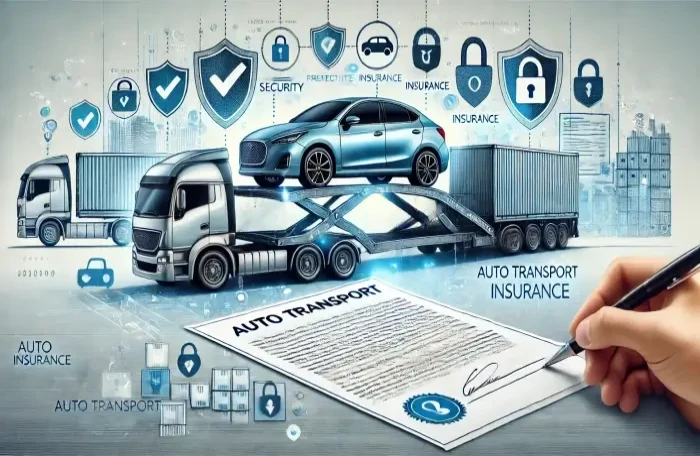Understanding Auto Transport Insurance: Key Information You Need

Lila Claybourne
Sep 20, 2024

When you decide to ship your vehicle, it's important to understand the insurance coverage involved. Auto transport insurance safeguards your vehicle during the entire shipping process, protecting you from potential damages, theft, and other unforeseen events. In this comprehensive guide, we’ll go into detail about different types of coverage, exclusions, and how you can make sure your vehicle is fully protected during transit.
What Is Auto Transport Insurance?
Auto transport insurance is a specialized form of coverage designed specifically to protect your vehicle during shipping. Unlike your personal auto insurance, which protects your car while it’s on the road, this insurance ensures that you’re covered for accidents, damage, or theft that may happen while your car is being transported on a carrier truck.
All carriers are required to have a minimum amount of liability insurance by law, but not all policies are comprehensive. It’s essential to understand what the carrier’s insurance covers and whether you need to purchase additional coverage for full protection.
Key Types of Auto Transport Insurance
There are two main forms of insurance to consider when shipping your vehicle: carrier, broker, and personal.
Carrier Insurance
Carriers—the companies physically transporting your vehicle—are required to have liability and cargo insurance to cover damages that may occur while your vehicle is in transit. This insurance typically covers:
Damage during transit: Scratches, dents, or damage from accidents while your vehicle is on the truck.
Damage during loading and unloading: Covers any incidents while loading or unloading the car from the carrier.
Theft protection: Although theft is rare, some policies will cover it if your vehicle is stolen while in the carrier's possession.
Federal law mandates that carriers have a minimum of $750,000 in liability coverage, but reputable companies often provide more, with some carrying up to $1,000,000 or more for added protection. However, it’s crucial to review the details, such as deductibles and coverage limits, to understand exactly what’s included.
Broker Insurance
Brokers connect you with carriers but don’t provide direct insurance coverage. In some cases, brokers may offer supplemental insurance or gap coverage to enhance protection. This is optional but may be beneficial if the carrier’s policy doesn’t cover the full value of your vehicle.
Customer’s Personal Insurance
Your personal auto insurance policy might not extend to cover damages during transit. However, it's a good idea to check with your insurance provider to see if there are any provisions for vehicle transportation. Some policies may include coverage during shipment, but most do not. Relying on personal auto insurance alone may leave you underinsured.
What Is Covered and What Is Not
Understanding the scope of auto transport insurance coverage will help you avoid potential pitfalls. Not everything is covered under standard policies, so it’s essential to know the specifics.
What’s Typically Covered:
Damage during transit: Most policies cover incidents like accidents, debris from the road, and improper securing that leads to scratches or dents.
Theft: Although theft during transport is rare, it is typically included if the vehicle is stolen while in the carrier's custody.
Damage during loading and unloading: Any damage caused while getting your vehicle on or off the truck is usually covered by the carrier’s insurance.
What’s Not Covered:
Pre-existing damage: Any damage that was present before the vehicle was shipped is not covered. This is why a thorough pre-shipping inspection is critical.
Personal items in the car: Most transport companies discourage leaving personal belongings in the car during shipping because their insurance policies won’t cover these items if they are damaged or stolen.
Mechanical issues: If your vehicle suffers mechanical failure during transport, it’s typically not covered unless it can be directly tied to mishandling by the carrier.
Acts of God: Natural disasters such as hurricanes, floods, or earthquakes are usually excluded from standard coverage, and you may need to purchase additional insurance for this type of protection.
Coverage Limitations and Exclusions
While auto transport insurance provides crucial protection, it’s important to be aware of the limitations and exclusions that could affect your claim.
Deductibles: Many auto transport insurance policies include deductibles, which is the amount you must pay out of pocket before the insurance coverage kicks in. Higher deductibles may reduce your premium but increase your financial responsibility in the event of damage.
Liability limits: Even if a carrier has $1 million in coverage, the specific policy may only cover a portion of your vehicle’s value. Make sure to review the liability limits carefully to ensure they meet your needs.
Exclusions: Common exclusions include damage from natural disasters, civil unrest, or pre-existing conditions. You can purchase additional coverage or gap insurance to address these gaps.
Additional Coverage Options
In addition to the basic coverage offered by carriers, there are other insurance options available to ensure full protection for your vehicle, especially if it’s high-value, classic, or exotic.
Gap Coverage: If the carrier’s insurance does not fully cover the value of your vehicle, gap coverage can help make up the difference between the carrier’s liability limit and your car’s actual value.
Total Loss Protection: In the rare event of a total loss during shipping, this type of insurance ensures that you receive the full value of your vehicle.
Expedited Shipping Insurance: If you pay extra for expedited services, you might consider purchasing insurance that covers potential delays or other issues that could impact delivery times.
How to Ensure Your Vehicle Is Covered Properly
To ensure your vehicle is adequately protected, it’s crucial to take proactive steps:
Choose a reputable broker: Always research the company’s reputation, check reviews, and confirm that they vet carriers and ensure they have proper insurance coverage for your vehicle.
Document your vehicle’s condition: Perform a thorough inspection of your vehicle before handing it over to the carrier. Take detailed photos and videos of the interior and exterior. This documentation will be vital if you need to file a claim for damages.
The Role of Personal Auto Insurance
Although personal auto insurance typically doesn’t cover damages during transit, it’s still a good idea to check with your provider to see if any additional protection is available. While most policies won’t extend coverage for shipping incidents, knowing the limitations of your policy will help you determine whether you need additional coverage or gap insurance.
How to File a Claim for Damages
In the unfortunate event that your vehicle is damaged during transport, it’s important to follow these steps:
Inspect the vehicle upon delivery: Before signing the Bill of Lading, inspect your vehicle thoroughly, noting any new damage. Be sure to document this damage with photos.
File the claim promptly: Immediately contact the transport company to begin the claims process. They will guide you through the steps, but having documentation will help speed up the process.
Keep detailed records: Make sure to keep copies of all relevant documents, including the Bill of Lading, the carrier’s insurance certificate, and any communications with the transport company.
Avoiding Auto Transport Scams and Fraud
While most companies are legitimate, there are a few bad actors in the auto transport industry. Protect yourself by following these steps:
Verify the company’s credentials: Make sure your broker checks the carrier’s USDOT and MC numbers on the FMCSA website to confirm that they are valid and in good standing.
Watch out for fake companies: Fraudulent companies may falsify documents to look legitimate. Make sure the company you choose has a proven track record and positive reviews.
Conclusion
Auto transport insurance is essential when shipping your vehicle, but understanding its limitations and knowing how to supplement it with additional coverage will give you peace of mind. By choosing a reputable carrier, documenting your vehicle’s condition, and familiarizing yourself with the claims process, you can ensure a smooth and secure transport experience.
For added peace of mind, let AmeriFreight take care of the vehicle shipping process for you. And while we’re at it, you can take advantage of our AFTA Total Assurance PLAN. The AFTA PLAN, on top of your personal vehicle insurance, helps cover your deductible costs if damage occurs. Learn more about how we can help you get your car to your destination and get a quote at AmeriFreight.
Related Posts
















